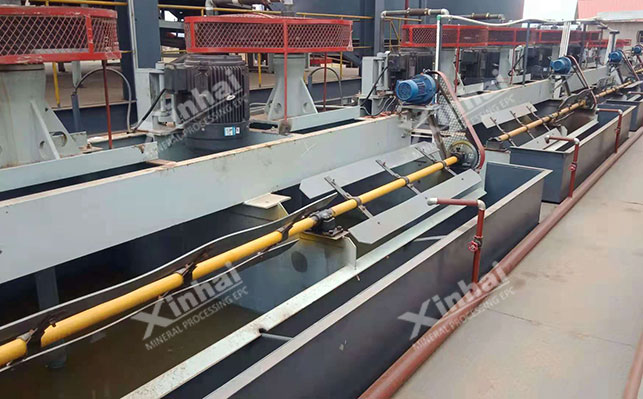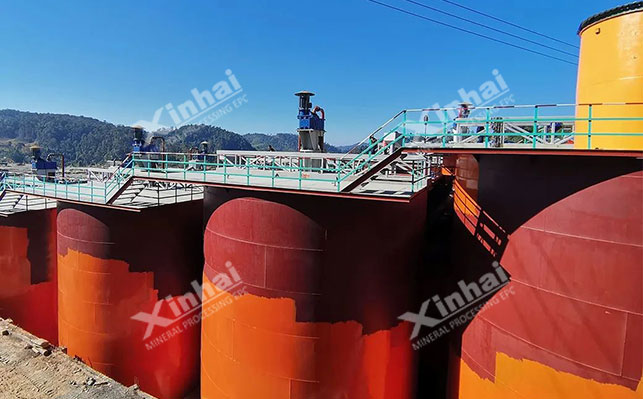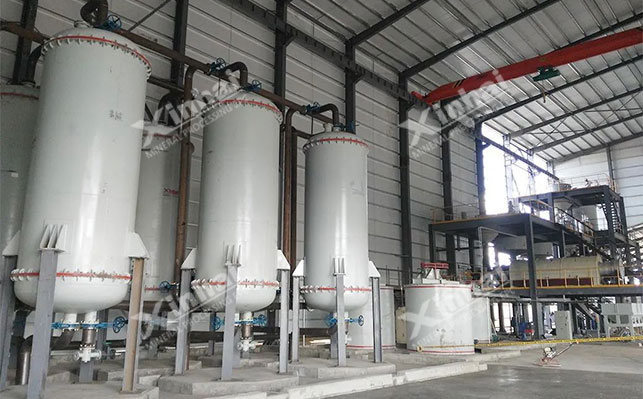
15311826613
Click to add WeChatCarbonaceous gold ore is defined as a difficult-to-leach gold ore containing organic carbon. The organic carbon in the mineral reacts with the gold-cyanide complex, so the single cyanide method cannot effectively extract gold. In addition, its "gold robbing" effect and the floatability similar to carbon gold make the flotation separation method more complicated, and the flotation index is poor. Based on the presence of carbon, the development of this type of gold is restricted. However, the resource reserves of this type of carbon-containing gold ore are large and widely distributed, and the development and utilization rate is less than 20%. In order to effectively improve the utilization rate of gold mines, it is necessary to develop and study carbon-containing gold ores. Let's take a look at what are the treatment methods for gold ore with high carbon content?
At present, the main treatment processes for gold ore with high carbon content include flotation, carbon suppression shielding and post-leaching (adding activated carbon or resin during leaching), pre-roasting, chemical oxidation, and biological oxidation pretreatment.

If the carbon and gold coexist in carbonaceous gold ore is simple, the method of first selecting carbon and then selecting gold is generally adopted to improve the grade of gold concentrate; when the carbon and gold coexist closely, mixed flotation of carbon and gold is often used, with high recovery rate index, but the grade of gold concentrate is generally less than 30g/t.
In the process of floating carbon-bearing gold ore, the particle size of gold embedding has a great influence on its flotation efficiency. The flotation method should be selected according to the symbiotic relationship between carbon and gold. There are usually preferential flotation to remove carbon, carbon suppression to select gold, flotation-gravity selection and flotation-cyanidation combined process to choose from.

In the cyanide gold extraction process, in order to reduce and reduce the adsorption of carbon to dissolved gold complex ions, light oils such as kerosene, diesel, pine oil, fuel oil, aromatic derivatives and para-nitroazosalicylic acid are often added to shield the adsorption of carbon to gold.
Generally, the effect of the shielding agent is strongly correlated with the carbon structure. At present, the most widely used shielding agent is NP-10 (long-chain polyethylene oxide), which can significantly improve the recovery rate of gold in the cyanidation process by combining with resin to adsorb cyanide and gold.
Roasting pretreatment mainly oxidizes carbon or makes it inactive, oxidizes sulfides and opens the fine packages of fine gold ore, which is also conducive to the agglomeration of fine gold. There are two roasting methods: traditional roasting (using a circulating boiling furnace) and microwave roasting.
When microwave roasting is used for gold ore with a gold grade of 36.2g/t, a sulfur content of 14.1%, and a carbon content of 4.08%, the gold leaching rate can reach 96% when roasted at 580~750℃ for 30~45min.
Microwave direct roasting can effectively remove carbon. Polar microwave indirect roasting with magnetite as the base material can achieve a carbon removal rate of up to 94%. Compared with conventional roasting, microwave roasting has low energy consumption, high heating speed and short roasting time. In comparison, roasting carbon removal is simple, and the leaching index is excellent after roasting pretreatment. However, this process requires large investment, high energy consumption, long roasting time, and gas emissions. In addition, carbonaceous gold ores contain sulfur and arsenic, and the environmental protection treatment cost is high. It is suitable for large and medium-sized mines.
Chemical oxidation pretreatment includes chlorination and pressure oxidation.
Chloride leaching method: Hypochlorite can passivate the adsorption of gold by carbon due to its strong oxidizing property, and can also oxidize the sulfide wrapped in gold and generate AuCl4- to accelerate the dissolution of gold and improve the gold leaching rate.

Pressure oxidation pretreatment method: It refers to adding acid, alkali, etc. under high temperature and high pressure oxidation conditions to decompose the sulfur and arsenic wrapped in gold in the ore, and the organic carbon is oxidized and reacts chemically in the environment to form stable carbonates.
In addition, some new methods are needed, such as carbon-chlorine-leaching gold extraction method, resin-chloride leaching method, etc. These methods can recover gold from difficult-to-leach carbonaceous gold ores and oxidized ores.
Although the chemical oxidation-passivation treatment gold extraction method can significantly improve the carbon leaching rate, its pretreatment process has high oxidant cost and serious pollution, and the pressurized oxidation process has high equipment requirements and is difficult to produce continuously. It is currently less used.
The biological oxidation pretreatment method is mainly used for pretreatment of gold ores with high sulfur and arsenic content. It has a simple process, mild environment and low energy consumption. Commonly used bacterial species for biological oxidation include Thiobacillus ferrooxidans, Thiobacillus thiooxidans, Leptospirillum ferrooxidans and white rot fungi, and their working mechanisms are as follows:
① Passivation, the metabolites of the thallus outside the bacterial cell cover the carbon surface, reducing and reducing the gold robbing effect;
② Biological enzyme free radical oxidation, fungal synthesis and secretion process produces free enzymes such as lignin degradation and aromatic ring degradation, these free enzymes and substrates destroy the gold robbing structure of the carbon surface and reduce the gold robbing ability;
③ Alkalinization chelation, unicellular fungi and streptomyces can produce and secrete carbon-containing bases, such as peptides and polyamines, to increase the pH value of the system and decompose carbon substances. However, some microorganisms can metabolize chelates, which can chelate and eliminate multivalent bond-bridge metal ions built on carbon, destroy the carbon structure and reduce the gold robbing ability.
The biological oxidation method for treating carbon-containing gold ores is subject to the bacterial strains, suitable temperature and organic carbon content. The suitable temperature is 45~55 ℃, the strain domestication and cultivation technology threshold is high, and the suitable organic carbon content does not exceed 2%, which has strong selectivity.
The above is an introduction to the treatment method of gold ores with high carbon content. In the actual mineral processing process, the selection of its process is based on the other mineral elements contained in the gold ore. Therefore, it is recommended to conduct mineral processing tests first, determine the ore composition through experimental analysis, and then design a suitable gold ore beneficiation process plan according to the situation, and determine the suitable gold ore beneficiation equipment to improve the gold ore beneficiation recovery rate.